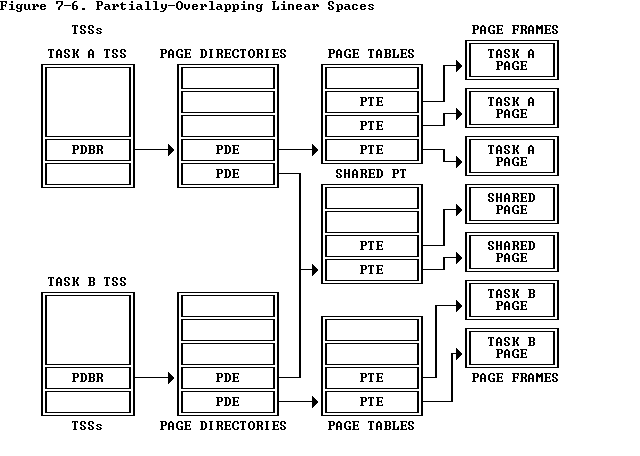up:
Chapter 7 -- Multitasking
prev: 7.6 Task Linking
next: Chapter 8 -- Input/Output
7.7 Task Address Space
The LDT selector and PDBR fields of the TSS give software systems designers
flexibility in utilization of segment and page mapping features of the
80386. By appropriate choice of the segment and page mappings for each task,
tasks may share address spaces, may have address spaces that are largely
distinct from one another, or may have any degree of sharing between these
two extremes.
The ability for tasks to have distinct address spaces is an important
aspect of 80386 protection. A module in one task cannot interfere with a
module in another task if the modules do not have access to the same address
spaces. The flexible memory management features of the 80386 allow systems
designers to assign areas of shared address space to those modules of
different tasks that are designed to cooperate with each other.
7.7.1 Task Linear-to-Physical Space Mapping
The choices for arranging the linear-to-physical mappings of tasks fall
into two general classes:
- One linear-to-physical mapping shared among all tasks.
When paging is not enabled, this is the only possibility. Without page
tables, all linear addresses map to the same physical addresses.
When paging is enabled, this style of linear-to-physical mapping
results from using one page directory for all tasks. The linear space
utilized may exceed the physical space available if the operating
system also implements page-level virtual memory.
- Several partially overlapping linear-to-physical mappings.
This style is implemented by using a different page directory for each
task. Because the PDBR (page directory base register) is loaded from
the TSS with each task switch, each task may have a different page
directory.
In theory, the linear address spaces of different tasks may map to
completely distinct physical addresses. If the entries of different page
directories point to different page tables and the page tables point to
different pages of physical memory, then the tasks do not share any physical
addresses.
In practice, some portion of the linear address spaces of all tasks must
map to the same physical addresses. The task state segments must lie in a
common space so that the mapping of TSS addresses does not change while the
processor is reading and updating the TSSs during a task switch. The linear
space mapped by the GDT should also be mapped to a common physical space;
otherwise, the purpose of the GDT is defeated.
Figure 7-6
shows how the
linear spaces of two tasks can overlap in the physical space by sharing
page tables.
7.7.2 Task Logical Address Space
By itself, a common linear-to-physical space mapping does not enable
sharing of data among tasks. To share data, tasks must also have a common
logical-to-linear space mapping; i.e., they must also have access to
descriptors that point into a shared linear address space. There are three
ways to create common logical-to-physical address-space mappings:
- Via the GDT. All tasks have access to the descriptors in the GDT. If
those descriptors point into a linear-address space that is mapped to
a common physical-address space for all tasks, then the tasks can
share data and instructions.
- By sharing LDTs. Two or more tasks can use the same LDT if the LDT
selectors in their TSSs select the same LDT segment. Those
LDT-resident descriptors that point into a linear space that is mapped
to a common physical space permit the tasks to share physical memory.
This method of sharing is more selective than sharing by the GDT; the
sharing can be limited to specific tasks. Other tasks in the system
may have different LDTs that do not give them access to the shared
areas.
- By descriptor aliases in LDTs. It is possible for certain descriptors
of different LDTs to point to the same linear address space. If that
linear address space is mapped to the same physical space by the page
mapping of the tasks involved, these descriptors permit the tasks to
share the common space. Such descriptors are commonly called
"aliases". This method of sharing is even more selective than the
prior two; other descriptors in the LDTs may point to distinct linear
addresses or to linear addresses that are not shared.

up:
Chapter 7 -- Multitasking
prev: 7.6 Task Linking
next: Chapter 8 -- Input/Output
